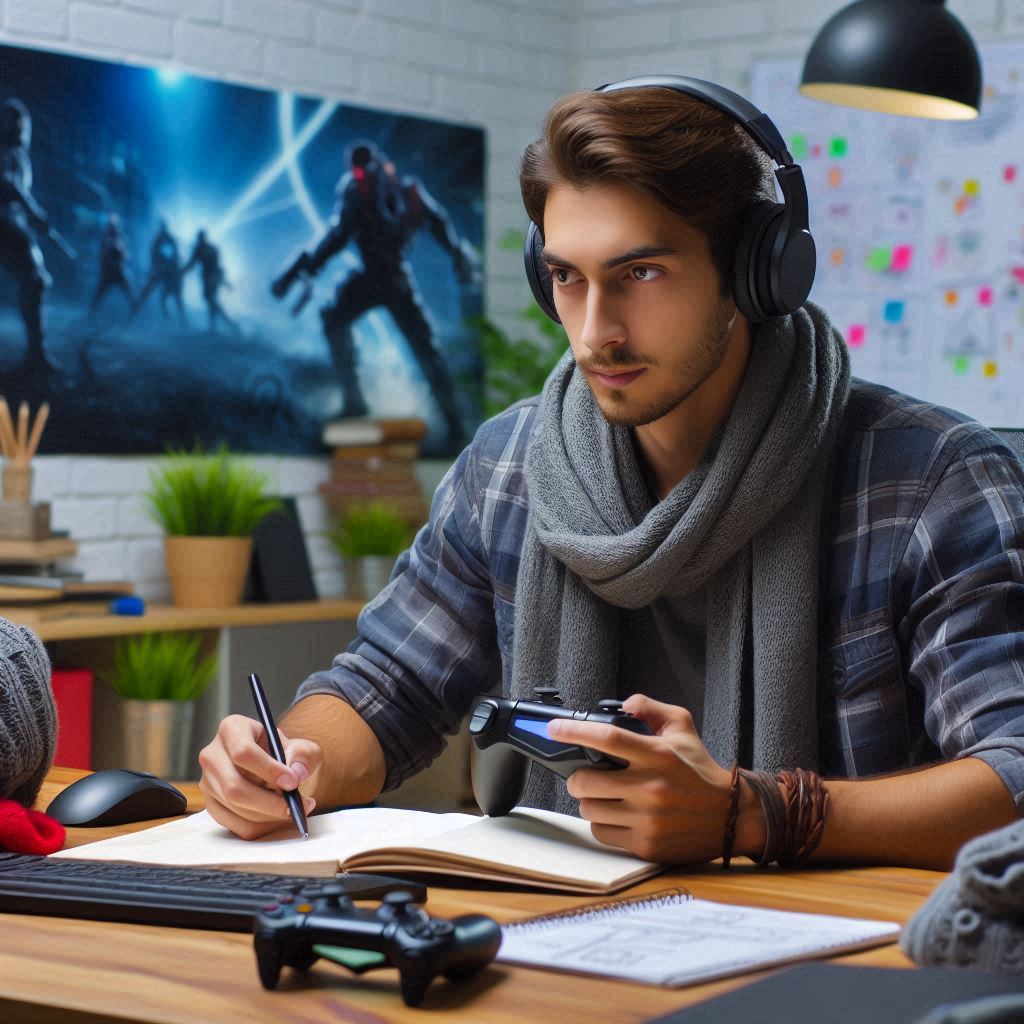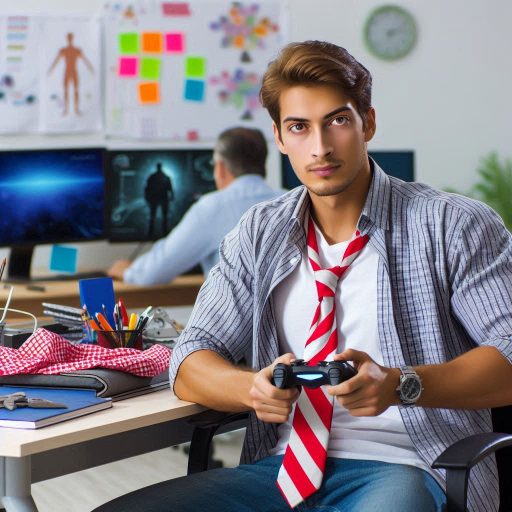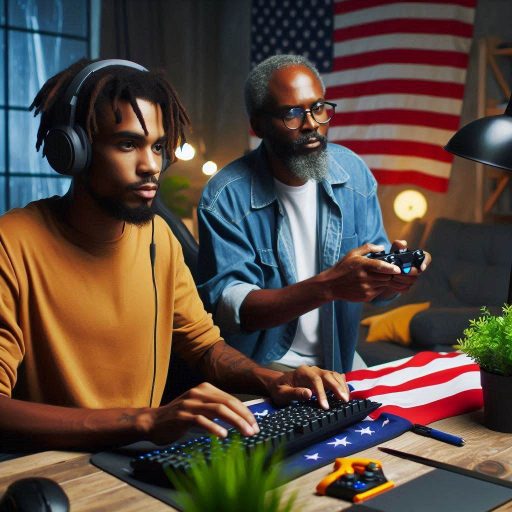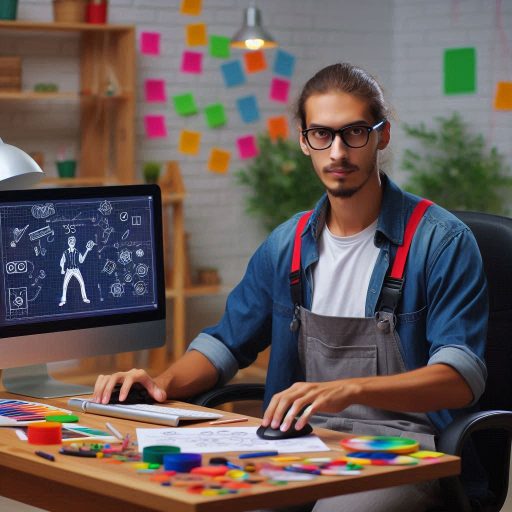Introduction
Game art and design are fundamental to the gaming industry, playing a pivotal role in creating immersive experiences.
The visual elements of a game, including character design, environments, and animations, directly impact how players interact with and enjoy the game.
High-quality game art grabs attention and draws players into a meticulously crafted world, making it feel vibrant and engaging.
Good design enhances storytelling, establishes mood, and guides players through the game, enriching their overall experience.
Effective game design ensures that each visual component serves a purpose, whether it’s to convey a character’s personality or set the tone for a scene.
The attention to detail in art and design can evoke emotions, inspire curiosity, and create memorable moments.
Conversely, subpar art and design can undermine gameplay, making it difficult for players to stay engaged.
In essence, game art and design are not just about aesthetics; they are integral to shaping the player’s journey and overall satisfaction.
Investing in these elements ensures that games are not only visually appealing but also provide a deeper, more compelling experience.
Understand the Fundamentals of Game Art and Design
To succeed in game art and design, mastering basic art principles is essential.
Color theory, composition, and perspective are the foundation of any visual medium.
These principles guide how elements interact within a scene, influencing both aesthetics and gameplay.
Understanding and applying these concepts will elevate your designs, ensuring visual coherence and player engagement.
The basic principles of art and design such as color theory, composition, and perspective
Color theory involves understanding how colors interact and how they can convey mood.
In game design, the color palette influences the emotional tone of the game.
Bright, vibrant colors can evoke excitement or joy, while muted tones may suggest a more somber or mysterious atmosphere.
Designers must consider how colors contrast, complement, or clash to create the desired impact.
This understanding allows you to craft immersive worlds that connect emotionally with players.
Composition refers to how elements are arranged within a scene.
In game art, strong composition guides the player’s attention and creates a visual flow.
The placement of objects, characters, and environments should lead the player’s eye toward important elements, like objectives or enemies.
Effective composition can enhance the gameplay experience by subtly directing player focus without disrupting immersion.
Understanding how objects appear based on their distance and position in relation to the viewer helps build believable game worlds.
Whether you’re designing a character or a landscape, using the right perspective will make your art appear dynamic and lifelike.
When these principles come together, they form the visual language of the game.
In game development, art is not just about making things look good; it’s about enhancing the gameplay experience.
For example, the correct use of color can highlight interactable objects, while good composition can ensure that the player doesn’t miss important details.
Well-executed perspective makes the game world feel larger and more immersive.
Understanding how these principles apply to game development
Game art needs to work seamlessly with mechanics, storytelling, and level design.
For example, character designs should reflect their role or personality, while environments must support the gameplay.
Without these basic principles, the game’s visuals may feel disjointed, confusing, or ineffective.
By mastering the fundamentals of game art and design, you can create visuals that enhance the overall game experience.
This keeps players engaged and invested in the world you build.
Stay Updated on Industry Trends
Staying current with industry trends is crucial in game art and design.
The gaming world evolves rapidly, and trends shift quickly.
Keeping up with these changes helps you stay competitive and relevant.
Importance of Staying Current
The gaming industry is dynamic and constantly innovating.
New technologies and techniques emerge, influencing how games are designed and visualized.
By staying updated, you can incorporate the latest trends into your work, ensuring your designs are fresh and engaging.
It also helps you anticipate what players will find appealing, enhancing user experience.
Trends in game art and design often reflect broader technological advancements and shifts in player preferences.
For example, advancements in graphics technology have led to hyper-realistic visuals and more immersive environments.
Staying informed allows you to adapt and integrate these advancements into your designs.
Popular Styles and Techniques
One of the prominent trends in game art is the rise of photorealism.
Games like The Last of Us Part II and Cyberpunk 2077 showcase highly detailed and realistic environments.
This trend emphasizes capturing lifelike textures and lighting, creating a more immersive experience.
Another popular style is stylized art.
Games such as Cuphead and Borderlands use unique visual styles that stand out.
These games employ exaggerated features, vibrant colors, and distinct artistic approaches to create memorable aesthetics.
Additionally, procedural generation has gained popularity.
This technique, seen in games like Minecraft and No Man’s Sky, generates game content algorithmically rather than manually.
It allows for vast, diverse worlds and experiences without extensive manual design work.
Virtual reality (VR) and augmented reality (AR) are also influencing game art.
VR games like Half-Life: Alyx require 360-degree art and interactive environments.
AR games, such as Pokémon GO, blend digital elements with the real world, requiring innovative design strategies to enhance player interaction.
Staying updated on industry trends is essential for success in game art and design.
Embracing new styles and techniques keeps your work relevant and engaging.
Whether you are exploring photorealism, stylized art, or VR and AR, remaining informed ensures you meet evolving player expectations and industry standards.
Read: Breaking Down Iconic Movie Costumes
Develop strong technical skills
Proficiency in Software Programs
Proficiency in software programs like Photoshop is essential for creating and manipulating high-quality graphics and artwork.
Artists should be comfortable using tools like layers, brushes, and filters to bring their creative vision to life.
Maya is another important software program for game artists and designers.
It is widely used for creating 3D models, animations, and visual effects in games.
Understanding how to navigate Maya’s interface and work with key features like polygon modeling and rigging is essential.
Unity is a popular game development platform that allows artists and designers to create interactive experiences for a variety of platforms.
Having a strong grasp of Unity’s tools and features, such as scripting in C# and working with animations, is crucial for game development success.
Resources for Improving Technical Skills
Online tutorials and courses are excellent resources for artists and designers looking to improve their technical skills.
Platforms like Udemy, Coursera, and Skillshare offer a wide range of courses on game art, design, and development.
These courses cover topics such as 3D modeling, texturing, lighting, animation, and level design.
By following structured tutorials and completing hands-on projects, artists can enhance their proficiency in software programs and hone their technical skills.
Additionally, online communities and forums provide valuable support and feedback for artists looking to improve their skills.
Engage with fellow artists to share work-in-progress projects and seek advice from experienced professionals.
This collaboration helps artists grow and improve their technical abilities.
Developing strong technical skills is vital for success in game art and design.
Artists and designers master software programs like Photoshop, Maya, and Unity to create captivating gaming experiences.
They use online resources to improve their skills, delivering immersive experiences to players globally.
Read: Freelance vs. In-House Costume Design Jobs
Collaborate effectively with team members
In game development, collaboration is key.
Working with artists, programmers, and designers to create a cohesive experience requires clear communication and teamwork.
Without these, even the most brilliant ideas can falter.
The Importance of Communication
Effective communication ensures every team member stays aligned with the project’s goals.
Developers, artists, and designers often have different perspectives, making communication essential to maintain a shared vision.
- Regular Meetings: Hold frequent check-ins to discuss progress, obstacles, and upcoming tasks.
- Use Clear Terminology: Speak in a language everyone understands, avoiding jargon specific to one discipline.
- Documentation: Keep detailed notes of discussions to prevent miscommunication and misunderstanding.
- Feedback Loops: Encourage team members to provide constructive feedback to improve the project continuously.
Foster Teamwork for Success
Teamwork doesn’t just happen; it requires effort and commitment from every individual.
Each team member must respect others’ expertise while contributing their own knowledge.
- Mutual Respect: Acknowledge the skills and contributions of all team members, regardless of their role.
- Conflict Resolution: Address disagreements quickly and professionally to keep the project on track.
- Celebrate Wins Together: Celebrate both small and big milestones to boost morale and motivation.
Tips for Working with Artists
Artists bring the game’s visuals to life.
A cohesive collaboration between artists and other team members ensures the game’s aesthetics match the gameplay.
- Define the Vision Early: Share concept art and sketches early to establish the visual direction.
- Respect Artistic Input: Allow artists creative freedom while offering constructive feedback.
- Regular Check-ins: Ensure the art team is involved in major discussions about the game’s evolution.
Tips for Working with Programmers
Programmers turn creative ideas into a playable reality.
Developers must maintain close collaboration with programmers to ensure the game functions smoothly.
- Stay Organized: Break down tasks into manageable sections to prevent programmers from feeling overwhelmed.
- Understand Limitations: Respect programming limitations and avoid demanding features that are technically infeasible.
- Collaborative Testing: Work closely with programmers during testing to identify and solve issues quickly.
Tips for Working with Designers
Game designers shape the overall experience.
Their collaboration with artists and programmers is crucial for creating seamless gameplay.
Transform Your Career Today
Unlock a personalized career strategy that drives real results. Get tailored advice and a roadmap designed just for you.
Start Now- Collaborate on Mechanics Early: Ensure designers and programmers agree on mechanics before development begins.
- Regular Playtesting: Test the game often to ensure the design translates well into the final product.
- Iterate Together: Adjust and refine game elements as a team based on player feedback.
Communication and collaboration are vital for successful game development.
By working closely with all team members, you ensure a cohesive and enjoyable game.
Read: Networking Events for Costume Designers

Seek feedback and iterate on designs
Encourage artists and designers to seek feedback from peers and mentors
To create outstanding game art, seeking feedback is essential.
Artists and designers must actively seek input from peers and mentors.
Feedback provides valuable insights into areas that may need improvement.
It also helps identify strengths that can be enhanced further.
Engaging with others during the design process fosters a collaborative environment where creativity can thrive.
When seeking feedback, artists should ask specific questions.
Ask peers or mentors what elements stand out and where they see room for improvement.
This approach encourages constructive criticism and promotes better understanding of the design’s impact.
Without feedback, creators may miss opportunities to refine their work.
The iterative process of refining and improving game art based on feedback
Game design is rarely perfect on the first attempt.
Iteration is a natural part of the creative process.
By iterating on their designs, artists can make improvements that elevate their game art.
Iteration means revisiting and refining designs to improve visuals and functionality.
It involves reviewing feedback and applying changes that enhance the final product.
Feedback serves as a guide during this iterative process.
It allows designers to pinpoint areas that need more attention.
Perhaps a character design lacks detail, or an environment could use more texture.
Feedback helps highlight these details so that changes can be made effectively.
Without feedback, iteration can feel directionless.
It’s also important to be open to constructive criticism.
Artists should avoid becoming too attached to their initial designs.
Being flexible allows for growth and improvement.
Embracing change based on feedback can lead to breakthrough moments in game design.
Some of the best game art emerges after several rounds of revision.
Iteration also offers a chance to experiment.
By trying new ideas and exploring different artistic approaches, designers can discover fresh ways to enhance their work.
Feedback during these experiments can help refine the new ideas, ensuring they align with the overall game’s vision.
Through continuous feedback and iteration, the design evolves naturally.
By seeking feedback and iterating on their work, artists and designers ensure their game art continuously improves.
This process leads to high-quality, polished designs that resonate with players.
Create a Strong Portfolio
Creating a compelling portfolio is essential for showcasing your game art and design skills.
A strong portfolio can make you stand out in the competitive gaming industry.
Here are some tips to help you craft a professional portfolio that highlights your skills and experience.
Showcase Your Best Work
- Select Quality Over Quantity: Choose only your best pieces to include in your portfolio.
Quality is more important than quantity. - Demonstrate a Range of Skills: Show versatility by including different types of art and design work.
Include character design, environment art, UI/UX design, and 3D modeling. - Highlight Your Strengths: Emphasize your strongest skills, whether it’s concept art, animation, or level design.
Tailor Your Portfolio to the Gaming Industry
- Know Your Audience: Research the company or project you’re targeting.
Tailor your portfolio to match the style and needs of potential employers. - Include Relevant Work: Feature work that aligns with the type of games you want to create.
Avoid including unrelated projects that don’t showcase relevant skills. - Use Game Art Context: Provide context by showing how your art fits into a game.
Include screenshots, gameplay clips, or in-game renders.
Insight into Your Creative Process
- Showcase Development Stages: Include sketches, concept art, and final renders to demonstrate your creative process.
This gives employers insight into your workflow. - Explain Your Decisions: Add brief descriptions that explain your design choices, techniques, and software used.
This helps viewers understand your approach and technical skills. - Include Before and After Comparisons: Show how your designs evolved from concept to final product to highlight your problem-solving skills.
Keep Your Portfolio Organized and Easy to Navigate
- Create a Clean Layout: Use a simple and professional layout that makes it easy to navigate your work.
Avoid clutter and focus on the artwork. - Group Similar Works Together: Organize your pieces into categories, like character design, environmental art, and animations, to make browsing easier.
- Use High-Quality Images: Ensure your images are high-resolution and properly formatted.
Blurry or poorly cropped images can harm your presentation.
Use an Online Portfolio Platform
- Choose the Right Platform: Use professional platforms like ArtStation, Behance, or your own website.
These platforms allow easy access to your work. - Optimize for Mobile: Ensure your portfolio looks great on both desktop and mobile devices.
Many industry professionals review portfolios on their phones. - Keep it Updated: Regularly update your portfolio with new work.
An up-to-date portfolio shows you’re active and continuously improving.
A well-curated portfolio can set you apart in the game art and design field.
Use these tips to showcase your talent effectively.
Read: Visual Merchandising: Best Practices for Beginners
Attend Industry Events and Network with Professionals
Attending game industry events, conferences, and workshops can significantly boost your career in game art and design.
These gatherings offer valuable opportunities to learn, network, and showcase your skills to potential employers and collaborators.
Here’s how attending industry events can benefit you and recommendations for networking effectively.
Benefits of Attending Industry Events
- Gain Industry Insights: Conferences and workshops provide firsthand insights into the latest trends, tools, and techniques in game design.
- Learn from Experts: Industry events feature seasoned professionals who share their experiences and knowledge through talks and panels.
- Stay Updated on Technology: Events often showcase new technologies, software, and best practices that can enhance your skills.
- Receive Constructive Feedback: Attendees can present their work to industry experts for feedback, which helps refine their skills and portfolios.
- Build Your Portfolio: Workshops often involve hands-on activities that can add valuable pieces to your portfolio, demonstrating your abilities to employers.
- Discover Job Opportunities: Many companies attend these events to scout for talent, making them ideal places to find job opportunities.
Recommendations for Networking Opportunities
- Attend Game Developer Conferences (GDC): GDC is one of the largest and most influential events in the gaming industry.
It offers sessions on game design, visual arts, programming, and more.
Attending GDC can connect you with leading professionals and companies. - Join Local Meetups and Game Jams: Local meetups and game jams are excellent for networking on a smaller scale.
These events encourage collaboration and creativity, helping you build relationships with local designers and developers. - Participate in Online Workshops and Webinars: If attending in person is not feasible, online workshops and webinars are great alternatives.
They offer the same learning and networking opportunities, often with a global reach. - Attend Indie Game Festivals: Festivals such as PAX, IndieCade, and EGX Rezzed showcase independent games and offer great networking opportunities.
Developers attending these events are often creative and innovative, making them ideal for collaboration. - Engage in Networking Sessions: Most conferences include designated networking sessions.
These sessions are ideal for meeting new people in a structured environment.
Prepare an introduction about your work and have business cards or portfolios ready.
Attending industry events and networking with professionals is essential for game artists and designers.
These experiences help you stay current, connect with key players, and open doors to future opportunities in game development.
Conclusion
Successful game art and design blend creativity, technical skills, and a deep understanding of player experience.
Master the fundamentals to create engaging game worlds.
Focus on color theory, composition, and character design.
Pay attention to detail and strive for consistency in your art style, ensuring that every element contributes to the overall atmosphere of the game.
Collaboration is crucial in game development.
Work closely with developers, writers, and other artists to ensure that the visual elements align with the game’s narrative and mechanics.
Open communication and a willingness to adapt are essential for overcoming challenges that arise during the design process.
Feedback plays a significant role in growth.
Accept constructive criticism and use it to refine your work.
Regularly seek feedback from peers, mentors, and even players to understand how your designs impact the gaming experience.
Iterating on feedback can lead to breakthroughs that elevate your art to the next level.
To succeed, you must also build a strong portfolio showcasing a range of skills and styles.
Highlight your best work, including concept art, character designs, environment art, and any collaborative projects.
A well-rounded portfolio demonstrates versatility and your ability to adapt to different game genres.
[E-Books for Sale]
The Big Book of 500 High-Paying Jobs in America: Unlock Your Earning Potential
$19.99 • 500 High-Paying Jobs • 330 pages
Explore 500 high-paying jobs in America and learn how to boost your career, earn more, and achieve success!
See All 500 High-Paying Jobs of this E-Book
1001 Professions Without a Degree: High-Paying American Jobs You Can Start Now
$19.99 • 1001 Professions Without a Degree • 174 pages
Discover 1001 high-paying jobs without a degree! Unlock career tips, skills, and success strategies for just $19.99!




